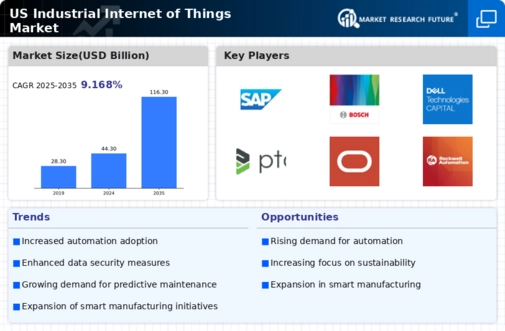Expansion of 5G Connectivity
The expansion of 5G connectivity is poised to revolutionize the industrial internet-of-things market. With its high-speed data transfer capabilities and low latency, 5G enables real-time communication between devices, facilitating seamless integration of IoT applications. This technological advancement is particularly beneficial for industries requiring instantaneous data processing, such as manufacturing and logistics. In the US, the rollout of 5G networks is expected to enhance the performance of IoT devices, potentially increasing the market size of the industrial internet-of-things market by over $10 billion by 2025. The enhanced connectivity provided by 5G is likely to drive innovation and efficiency across various sectors.
Rise of Predictive Maintenance
Predictive maintenance is emerging as a crucial driver in the industrial internet-of-things market. By utilizing IoT sensors and data analytics, companies can monitor equipment health in real-time, predicting failures before they occur. This proactive approach minimizes unplanned downtime and extends the lifespan of machinery. In the US, industries that adopt predictive maintenance strategies can potentially reduce maintenance costs by up to 25% and increase productivity by 20%. The shift towards predictive maintenance reflects a broader trend of operational excellence within the industrial internet-of-things market, as organizations seek to enhance reliability and efficiency in their operations.
Integration of Advanced Analytics
The integration of advanced analytics into the industrial internet-of-things market is driving significant transformation within the sector. By leveraging data analytics, organizations can derive actionable insights from vast amounts of data generated by connected devices. This capability enhances decision-making processes, leading to improved operational efficiency and reduced downtime. In the US, the market for advanced analytics is projected to reach approximately $30 billion by 2026, indicating a robust growth trajectory. Companies are increasingly investing in analytics tools to optimize their supply chains and production processes. This trend suggests that the industrial internet-of-things market is becoming more data-driven, enabling businesses to respond swiftly to market demands and operational challenges.
Government Initiatives and Support
Government initiatives and support play a pivotal role in the growth of the industrial internet-of-things market. Various federal and state programs are being implemented to promote the adoption of IoT technologies across industries. These initiatives often include funding for research and development, tax incentives, and the establishment of IoT innovation hubs. In the US, the government has allocated substantial resources to enhance digital infrastructure, which is expected to bolster the industrial internet-of-things market. Such support not only encourages private sector investment but also fosters collaboration between public and private entities, driving technological advancements and market expansion.
Focus on Workforce Training and Development
The focus on workforce training and development is increasingly recognized as a critical driver in the industrial internet-of-things market. As organizations adopt IoT technologies, there is a growing need for skilled professionals who can manage and analyze the data generated by these systems. In the US, companies are investing in training programs to equip their workforce with the necessary skills to leverage IoT effectively. This emphasis on education and skill development is essential for maximizing the benefits of the industrial internet-of-things market. By fostering a knowledgeable workforce, organizations can enhance productivity and innovation, ensuring they remain competitive in a rapidly evolving technological landscape.

























Leave a Comment